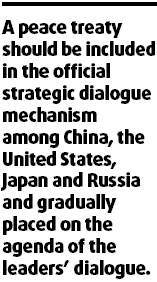The security situation in Northeast Asia has been consistently complicated over the past 50 years, featuring interweaving conflicts, old and new, and a large number of unsafe and destabilizing factors.
 On the one hand, the fragile peace that took shape during the Cold War years has been maintained; on the other, however, as the scars and wounds caused by wars and conflicts in the region since World War II are left unhealed, the possibility of having all potential security risks in the region properly addressed in the near future remains elusive. In particular, the outbreak of the Korean Peninsula nuclear crisis has turned Northeast Asia into one of world's trouble spots, less serious only than the Middle East.
On the one hand, the fragile peace that took shape during the Cold War years has been maintained; on the other, however, as the scars and wounds caused by wars and conflicts in the region since World War II are left unhealed, the possibility of having all potential security risks in the region properly addressed in the near future remains elusive. In particular, the outbreak of the Korean Peninsula nuclear crisis has turned Northeast Asia into one of world's trouble spots, less serious only than the Middle East.
The following are the major potential security risks in the region:
1. On the Korean Peninsula nuclear crisis, a light appears to have emerged as chief delegates to the Six-Party Talks on the issue wrapped up their talks in Beijing on Friday with a schedule for further meetings on the denuclearization process. However, given the weak political trust between the United States and the Democratic People's Republic of Korea (DPRK), any positive statement of substantive progress from the talks on the crisis seemed too early. Should the talks on the Korean nuclear crisis fail to find a way out of the difficult situation, the danger of a nuclear arms race taking place in Northeast Asia and even slipping out of control will grow substantial.
2. The United States and Japan, the world's leading economic powers, have constantly strengthened and deepened their security alliance, bringing pressure to other countries in the region. These moves, aimed at seeking self security at the expense of a sense of security for others, is less than conducive to the fostering of enduring peace in the region.
3. In spite of a relaxed military standoff between the North and the South on the Korean Peninsula, the two sides are still engaged in frequent military exercises aimed at deterrence and anti-deterrence as well as containment and anti-containment. With tension embedded in the fragile peace, the prospect of unification on the peninsula remains slim.
4. Disputes among countries over territorial and maritime rights keep cropping up. These disputes, if mishandled, might touch off new crises.
In addition, the separatist forces in Taiwan headed by Chen Shui-bian still cling tight to their "independence" attempts, thus posing a grave threat to the peace of Taiwan and the region as a whole.
My proposal of a new security pattern in Northeast Asia is based on the fact that the region has had no reliable security mechanism since the Korean War and the ideology-based security alliances among some countries are incapable of ensuring lasting peace in the region. I am also of the view that the unique historical background of Northeast Asia makes the security patterns elsewhere unfitting to the region. Hence, a new pattern should be built in the region that is based on the actual diversity of the region and acceptable to all sides concerned.
1. The European pattern does not fit Northeast Asia.
Profound changes took place on the European security landscape after the end of the Cold War. There used to be two military rivals in Europe. But one of them ceased to exist following the disintegration of the former Soviet Union and the Eastern European bloc, leaving the other one at a loss for new defense goals with the loss of a rival on its par. Despite present setbacks in the European integration process, the call for peacefully building a new Europe has become the main theme of the whole continent.
The security situation in Northeast Asia, in contrast, bears little room for optimism. First and foremost, the above problems could hardly be properly solved soon. Second, given the varied historical and cultural backgrounds as well as varying level of economic development among Northeast Asian countries, the region is not equipped with conditions for integration in the way Europe is. 
However, the yearning for peace and development and the urgent need for a peaceful regional environment for their economic and social development in all countries in the region make it utterly necessary to build a new security pattern in Northeast Asia that is binding to all countries in the region.
2. My thinking for the future new security pattern in Northeast Asia is: take the Six-Party Talks on the Korean nuclear issue as an opportunity to push forward the building of enduring peace in the region.
A specific proposal is as follows: through joint efforts, six parties should endeavor to materialize the 9.19 and 2.13 consensus reached during the 6th round Six-Party Talks, and on this basis, a regional summit on peace and security can be held with the conclusion of a Peace Treaty in Northeast Asia in the 21st Century.
The purpose of this summit is: propose basic principles for enduring peace in the region based on the diversity in Northeast Asian countries; reach an agreement in principle on concluding the Peace Treaty in Northeast Asia in the 21st Century; based on this summit, governments concerned designate experts and scholars to draft the specific clauses of this Peace Treaty in Northeast Asia in the 21st Century, which can be discussed and adopted in a regional international conference, then submitted to the governments concerned for signature and entry into force, and to the United Nations for record.
Conclusion of such a new treaty will have the following effects:
First, the series of issues left over from history in the region will be further cooled down and enabling conditions will be created for their final peaceful solution.
Second, antagonism among countries in the region because of differences in ideology will be greatly eased.
Third, fostering a relatively enduring regional environment of peace will be conducive to regional economic integration, which will benefit the United States, all East Asian countries and Oceanic countries. Deepened economic integration in the region will, in turn, be a positive force for regional peace and security.
3. To rebuild the peace and security pattern in Northeast Asia requires major countries in the region such as China, the United States, Japan and Russia to take the lead while all other countries in the region to take an active part.
To be frank, it is not easy to conclude a Peace Treaty in Northeast Asia in the 21st Century. But it is a treaty well worth the efforts of all the countries in the region despite the different values they uphold. Nonetheless, whether such a new pattern could be built depends on the political will of China, the US, Japan and Russia. Major countries in the region must realize that upholding long-term peace and stability in Northeast Asia not only serves their long-term interests, but also makes them responsible to other countries in the region. To this end, may I make a bold suggestion that the idea of concluding a peace treaty should be included in the official strategic dialogue mechanism among China, the United States, Japan and Russia and gradually placed on the agenda of the leaders' dialogue.
After an "ice-breaking trip" to China by Prime Minister Shinzo Abe, Chinese Premier Wen Jiabao paid a very successful "ice-melting trip" to Japan in April. The Joint Communique issued by the two governments made the two peoples and the people of the rest of the world see again the dawn of peaceful cooperation between China and Japan, the two major powers in Asia. As two major countries in Northeast Asia, China and Japan are responsible for making efforts for enduring peace in the region. So I suggest that experts and scholars of China and Japan meet regularly to have in-depth exchanges of views on such an important issue.
The author is president of the Chinese People's Institute of Foreign Affairs


No comments:
Post a Comment